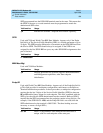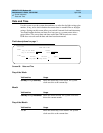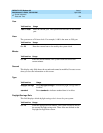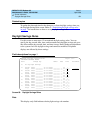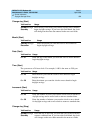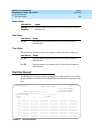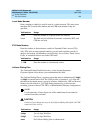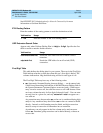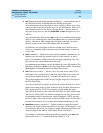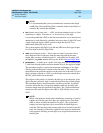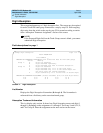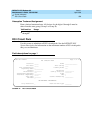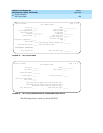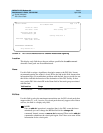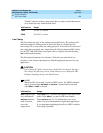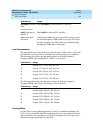
DEFINITY ECS Release 8.2
Administrator’s Guide
555-233-506
Issue 1
April 2000
Screen reference
596Dial Plan Record
17
■ ars (Automatic Route Selection shortcut dialing)— can be entered only if
the ARS field and the AAR/ARS Shortcut Dialing field on the
System-Parameters Customer-Option screen are both y. When an ars entry
is used to route a call, the caller has access to all ARS features. Enter ars in
any column but only for first digits 0 through 9 and *. You can enter ars
only once in a given row, and only
extension or attd can appear on a row
with ars.
Any extension entry that precedes
ars on the row is considered during digit
analysis. Any extension entry that follows
ars on the row cannot be dialed
directly. Instead, an ARS number must be dialed, and digit conversion
must be set up to convert the ARS number into an extension.
An attd entry can only appear in the first column and so attd can never
follow ars. Attendant group extensions can be dialed directly, without an
access code.
■ attd (Attendant) — Defines how users call an attendant. Attendant access
numbers can start with any number from 0 to 9 and contain 1 or more
digits. If a telephone’s COR restricts the user from originating calls, this
user cannot access the attendant using this code.
(An attendant group number can also be defined as a two-digit number. The
first digit is defined as "
misc" on the First Digit Table, and the second digit
(
0 through 9) is defined on the Second Digit Table screen.
■ dac (Dial access codes) — Allows you to use trunk access codes (TAC)
and feature access codes (FAC) in the same range. Dial access codes can
start with any number from 0–9, * or # and can contain up to 4 digits.
The system requires that a DAC have the longest length for a first digit in
the First Digit Table.
You can use the DAC to activate or deactivate a switch feature or to seize a
trunk from a trunk group, or both. In the first case, the DAC functions as a
FAC, in the second as a TAC.
For example, you can define the group
300–399 for dial access codes, and allow both FAC and TAC in that range.
You can use 4-digit DACs for ordinary trunk access, but they do not work
for attendant control of trunk groups, trunk-ID buttons, or DCS, and only
the last 3 digits of the codes can be recorded in CDR records. A DAC must
be the last item entered in a row when mixed station numbering is used.
■ extension (primary extension)
— Defines extension ranges that can be
used on your system.
Extension can have a first digit of 0 through 9 (* and
# not allowed) and can be 1 to 5 digits in length. Extension cannot have the
same first digit as the ARS or AAR feature access code (FAC).
For example, if extensions 400 through 499 are required, enter
ext at the
intersection of the "-3-" column and the First Digit "4" row.



